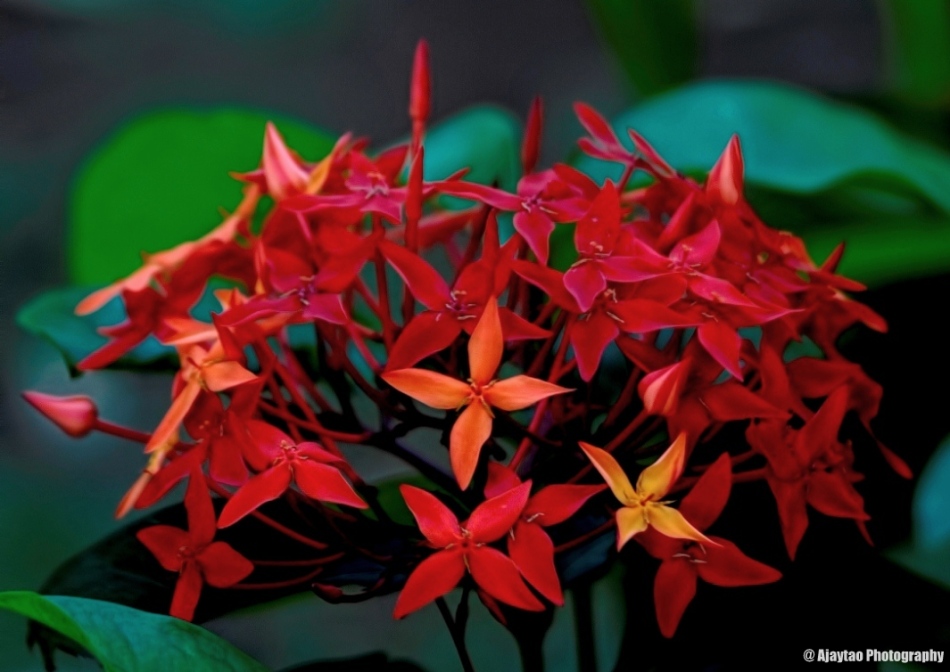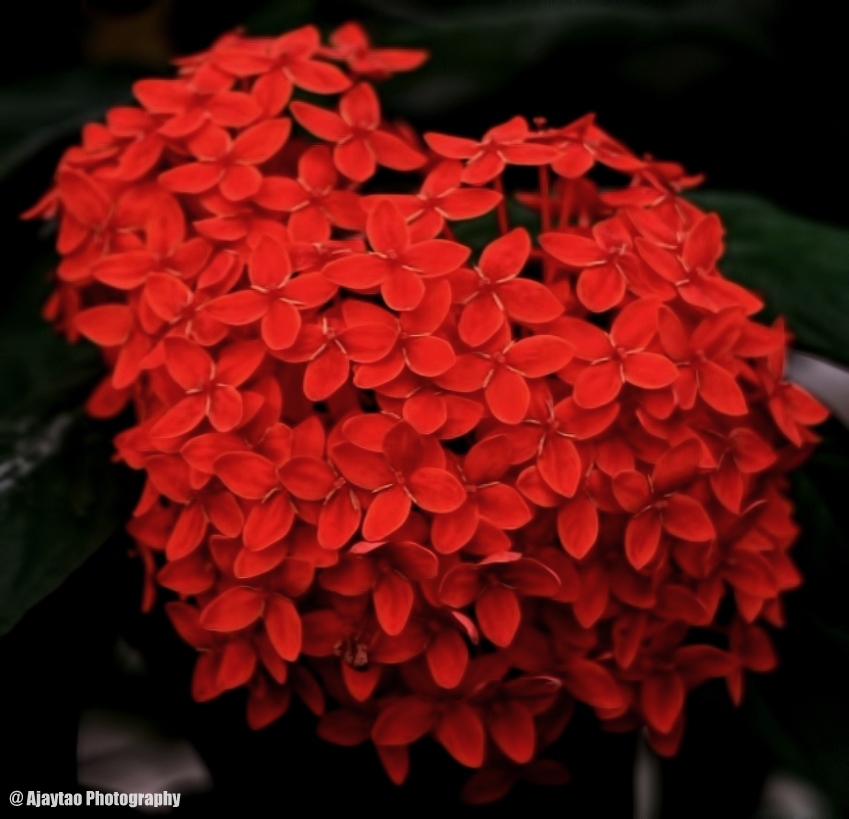Ixora coccinea – Jungle geranium – Ajaytao
Common name: Ixora, Jungle geranium, Cambodia: Kam rontea, Indonesia: Santan, Malay: Pechah priok, Vietnam: Dun trung quoc, dun do
Hindi: Rugmini रुग्मिनी
Botanical name: Ixora coccinea
Family: Rubiaceae (coffee family)
Ixora coccinea or jungle geranium, flame of the woods, and jungle flame) is a species of flowering plant in the Rubiaceae family. It is a common flowering shrub native to Southern India and Sri Lanka. There are about 400 species spread from Africa to India to Southern Asia. It has become one of the most popular flowering shrubs in South Florida gardens and landscapes. Its name derives from an Indian deity.
Ixora coccinea is a dense, multi-branched evergreen shrub, commonly 4–6 ft (1.2–2 m) in height, but capable of reaching up to 12 ft (3.6 m) high. It has a rounded form, with a spread that may exceed its height. The glossy, leathery, oblong leaves are about 4 in (10 cm) long, with entire margins, and are carried in opposite pairs or whorled on the stems. Small tubular, scarlet flowers in dense rounded clusters 2-5 in (5–13 cm) across are produced almost all year long.
Related to the gardenia and coffee plants, Ixora is said to be native to Asia and whose name derives from an Indian deity. They differ in leaf size, plant height, flower size and flower color. This plant which blooms throughout the year is easy to grow. The flowers are found in a wide range of colours. Plants are of two types- large; with height around 1 meter and dwarf or miniature plants. Miniature ones have small leaves and are bushy. Ixora flowers last well when picked and put into a vase with water, making an attractive home arrangement. Ixora flower has traditionally been associated with enhanced sexuality and the re-kindling of passion.
Water Ixora as needed to keep the soil evenly moist, but not muddy. Although the plant prefers moist soil, it may rot in excessively soggy soil. Water the shrub sparingly during the winter months.
Feed Ixora in early spring, using an acidic fertilizer formulated for Ixora, azalea and gardenias, which has a ratio such as 4-8-8, along with minor elements that are beneficial. Repeat in midsummer and autumn. Acidic fertilizer is especially important if the foliage takes on a yellowish cast, indicating a magnesium deficiency caused by improper soil pH. Apply the fertilizer according to label specifications, then water deeply.
Spread at least 3 to 4 inches of organic mulch such as pine needles, compost, shredded leaves or bark chips, on the soil around the Ixora plant to conserve soil moisture and help maintain a proper acidic soil pH. In spring, remove the mulch along with the top crust of soil. Replace the removed mulch and soil with fresh mulch.
Prune Ixora after blooming slows in late autumn or anytime the shrub looks untidy. Prune each shoot down to just one bud or prune the shrub as needed to create the size and shape desired. Izora shrubs tolerate pruning well and can be trimmed back by several inches without harm. However, many gardeners prefer to leave the shrub unsheared for a more natural appearance.
Protect Ixora from aphids and scales. Aphids are tiny, green insects that congregate at joints of the leaves and stems or the undersides of the leaves. Scales are hard-shelled insects that give the foliage a waxy appearance. Regular application of an insecticidal soap spray or neem oil usually helps to control both pests.
Although there are around 500 species in the genus Ixora, only a handful are commonly cultivated, and the common name, Ixora, is usually used for I. coccinea. I. coccinea is used in warm climates for hedges and screens, foundation plantings, massed in flowering beds, or grown as a specimen shrub or small tree. In cooler climes, it is grown in a greenhouse or as a potted house plant requiring bright light. I. coccinea is also grown in containers, looking very distinguished as a patio or poolside plant. This tight, compact shrub is much branched and tolerates hard pruning, making it ideal for formal hedges, although it is at its best when not sheared.
Ixora coccinea in Thiruvananthapuram, India.
There are numerous named cultivars differing in flower colour (yellow, pink, orange) and plant size. Several popular cultivars are dwarfs, usually staying under 3 ft (1 m) in height. Ixora ‘Nora Grant’ is a popular dwarf and ‘Super King’ is a popular hybrid with much larger flower clusters than the species. Many new cultivars and hybrids of I. coccinea have come to market in the last couple of decades, leading to a resurgence in popularity for the beautiful flame-of-the-woods.
Phytochemical studies indicate that the plant contains the phytochemicals lupeol, ursolic acid, oleanolic acid, sitosterol, rutin, lecocyanadin, anthocyanins, proanthocyanidins, and glycosides of kaempferol and quercetin.
Medicinal uses
The flowers, leaves, roots, and the stem are used to treat various ailments in the Indian traditional system of medicine, the Ayurveda, and in various folk medicines. The fruits, when fully ripe, are used as a dietary source.
Used for dysenteric diarrhea and associated colic pains.
Flowers used for dysentery and leucorrhea.
Poulticed fresh leaves and stems for sprains, eczema, boils and contusions.
Diluted tincture of roots for mouthwash and gargles for sore throat.
Flower decoction used for hypertension, amenorrhea and irregular menstruation, hemoptysis, catarrhal bronchitis.
Decoction of leaves for wounds and skin ulcers.
Flowers and bark used for blood-shot eyes, dysentery.
Considered internally sedative, stomachic, tonic, antiseptic, cholagogue; externally, astringent and antiseptic.
Hepatoprotective, chemoprotective, antimicrobial, antioxidant, antinociceptive, anti-inflammatory.
Stimulates gastric secretions.
Flowers considered cytotoxic, hepatoprotective, antimicrobial.
Ajaytao Photography




Recent Comments